- grandMA2 User Manual
- New in the Manual
- Introduction
- About this manual
- System requirements grandMA2 onPC
- Installation of grandMA2 onPC
- Help from MA technical support
- Safety Information
- Symbols used
- Intended use
- Dangers caused by electric current
- General safety instructions
- Device Overview
- grandMA2 console
- grandMA2 replay unit (RPU)
- grandMA2 fader wing
- MA onPC command wing
- MA onPC fader wing
- System Overview
- Standalone systems
- Network systems
- What is the replay unit (RPU)
- What is the network processing unit (NPU)
- What is the MA video processing unit (VPU)
- What is the network dimmer processor (NDP)
- What is MA 3D
- What are the MA nodes
- Paramters vs. DMX channels
- Parameter expansion
- Big systems
- Media systems and CITP
- First Steps
- Unpack the device
- Check scope of delivery
- Position the device
- Connect power
- Connect desk lamps
- Connect external screens
- Connect USB mouse and USB keyboad
- Connect DMX
- Connect sound
- Connect SMPTE (LTC)
- Connect Ethernet
- Connect analog remote control
- Connect grandMA2 fader wing
- Setup your PC
- Turn on the console the first time
- Keys & Buttons on the Console
- Key overview
- >>> [GoFastForward]
- <<< [GoFastBack]
- . [Dot]
- Align
- Assign
- At
- Backg [Background]
- Backup
- Blind
- Bt Pg +
- Bt Pg -
- B.O. [Blackout]
- Channel
- Ch Pg +
- Ch Pg -
- Clear
- Copy
- Cue
- Del [Delete]
- Down
- Edit
- Effect
- [Encoder]
- Esc
- Exec [Executor]
- Executor Buttons
- Fd Pg +
- Fd Pg -
- Fix
- Fixture
- Freeze
- Full
- Go + [small]
- Go + [large]
- Go - [small]
- Go - [large]
- Goto
- Group
- Help
- Highlt [Highlight]
- If
- Keyboard
- Learn
- List
- MA
- Macro
- [Minus] -
- Mouse
- Move
- Next
- [Numeric]
- Off
- On
- Oops
- Page
- Pause [small]
- Pause [large]
- Please
- [Plus] +
- Preset
- Prev [Previous]
- Prvw [Preview]
- Select
- Sequ [Sequence]
- Set
- Setup
- Solo
- Store
- Temp
- Thru
- Time
- Top
- Tools
- Up
- Update
- User 1
- User 2
- View
- U1 - U4
- V1 - V10
- X1 - X20
- Workspace
- User interface
- Screen layout
- User-defined area
- Command line
- X-Key labels
- View buttons
- Master section
- Time control
- Encoder bar
- Preset control bar
- Encoder toolbar
- Encoder settings
- Command wing bar
- Command section
- Mini executor bar
- Work with views
- Touch gestures
- Calculator
- Info
- Oops and undo
- Colors
- System
- Marker
- Cue
- Text indicators and symbols
- Icons
- Keyboard shortcuts
- Turn on or turn off the keyboard shortcuts
- Edit keyboard shortcuts
- Add or delete keyboard shortcuts
- Export or import keyboard shortcuts
- User interface
- Windows in General
- Create and manage basic windows
- Clear the screen or delete windows
- Command Syntax and Keywords
- General syntax rules
- Helping keywords
- Object keywords
- Function keywords
- All keywords
- Special characters
- <<< [GoFastBack]
- >>> [GoFastForward]
- - [Minus]
- + [Plus]
- AddUserVar
- AddVar
- Agenda
- Alert
- Align
- AlignFaderModules
- All
- AllButtonExecutors
- AllChaseExecutors
- AllFaderExecutors
- AllRows
- AllSequExecutors
- And
- Appearance
- Asterisk *
- Assign
- At
- At @
- Attribute
- AutoCreate
- Backup
- Black
- Blackout
- BlackScreen
- Blind
- BlindEdit
- Block
- ButtonPage
- Call
- Camera
- ChangeDest
- Channel
- ChannelFader
- ChannelLink
- ChannelPage
- Chat
- CircularCopy
- Clear
- ClearActive
- ClearAll
- ClearSelection
- Clone
- CmdDelay
- CmdHelp
- Copy
- CrashLogCopy
- CrashLogDelete
- CrashLogList
- Crossfade
- CrossfadeA
- CrossfadeB
- Cue
- Cut
- Default
- DefGoBack
- DefGoForward
- DefGoPause
- Delay
- Delete
- DeleteShow
- DisconnectStation
- Dmx
- Dollar $
- DmxUniverse
- Dot .
- DoubleRate
- DoubleSpeed
- Down
- DropControl
- Edit
- Effect
- EffectAttack
- EffectBPM
- EffectDecay
- EffectDelay
- EffectFade
- EffectForm
- EffectHigh
- EffectHZ
- EffectID
- EffectLow
- EffectPhase
- EffectSec
- EffectSpeedGroup
- EffectWidth
- Empty
- EndIf
- EndSession
- Escape
- ExecButton1
- ExecButton2
- ExecButton3
- Executor
- Exit
- Export
- Extract
- Fade
- FadePath
- Fader
- FaderPage
- Feature
- Filter
- Fix
- Fixture
- FixtureType
- Flash
- FlashGo
- FlashOn
- Flip
- Form
- Freeze
- Full
- FullHighlight
- Gel
- Go
- GoBack
- Goto
- Group
- HalfRate
- HalfSpeed
- Help
- Highlight
- IdentifyFaderModule
- If
- IfActive
- IfOutput
- IfProg
- Image
- Import
- Info
- Insert
- Interleave
- Invert
- InviteStation
- Item3D
- JoinSession
- Kill
- Label
- Layer
- Layout
- Learn
- LeaveSession
- List
- ListEffectLibrary
- ListFaderModules
- ListLibrary
- ListMacroLibrary
- ListOops
- ListOwner
- ListPluginLibrary
- ListShows
- ListUpdate
- ListUserVar
- ListVar
- Load
- LoadNext
- LoadPrev
- LoadShow
- Locate
- Lock
- Login
- Logout
- Lua
- Macro
- ManualXFade
- Mask
- Master
- MasterFade
- MAtricks
- MAtricksBlocks
- MAtricksFilter
- MAtricksGroups
- MAtricksInterleave
- MAtricksReset
- MAtricksWings
- MediaServer
- Menu
- Message
- Messages
- MidiControl
- MidiNote
- MidiProgram
- Model
- Move
- Move3D
- NetworkInfo
- NetworkNodeInfo
- NetworkNodeUpdate
- NetworkSpeedTest
- NewShow
- Next
- NextRow
- Normal
- Off
- On
- Oops
- Or
- OutDelay
- OutFade
- Page
- Parentheses ( )
- Park
- Part
- Paste
- Pause
- Plugin
- PMArea
- Preset
- PresetType
- Preview
- PreviewEdit
- PreviewExecutor
- Previous
- PrevRow
- Profile
- Protocol
- PSR
- PSRList
- Quotation marks " "
- PSRPrepare
- Rate
- Rate1
- RdmAutomatch
- RdmAutopatch
- RdmFixtureType
- RdmInfo
- RdmList
- RdmSetParameter
- RdmSetpatch
- RdmUnmatch
- Reboot
- Record
- Release
- ReloadPlugins
- Remote
- RemoteCommand
- Remove
- RemoveIndividuals
- Replace
- ResetDmxSelection
- ResetGuid
- Restart
- Root
- Rotate3D
- SaveShow
- Screen
- Search
- SearchResult
- Select
- SelectDrive
- Selection
- Semicolon ;
- SelFix
- Sequence
- SetHostname
- SetIP
- SetNetworkSpeed
- Setup
- SetUserVar
- SetVar
- ShuffleSelection
- ShuffleValues
- Shutdown
- SnapPercent
- Slash /
- Solo
- SpecialMaster
- Square brackets [ ]
- Speed
- StepFade
- StepInFade
- StepOutFade
- Stomp
- Store
- StoreLook
- Surface
- Swop
- SwopGo
- SwopOn
- SyncEffects
- TakeControl
- Telnet
- Temp
- TempFader
- Thru
- Timecode
- TimecodeSlot
- Timer
- ToFull
- Toggle
- Tools
- Top
- ToZero
- Unblock
- Unlock
- Unpark
- Up
- Update
- UpdateFirmware
- UpdateSoftware
- UpdateThumbnails
- User
- UserProfile
- Value
- Version
- View
- ViewButton
- ViewPage
- WebRemoteProgOnly
- With
- World
- Zero
- Work with lists
- Object list
- Selection list
- Executor list
- Attribute list
- Station list
- General syntax rules
- Using the Backup Menu
- New show
- Load show
- Save show
- Save show as...
- Delete shows
- Using a USB stick
- Setting up a file server
- Partial show read
- ASCII show read
- Save as grandMA3
- Single User and Multi User Systems
- The difference between a single user and a multi user system
- Create user profiles and users
- User settings
- Login
- Networking
- What is networking
- Set the IP address in the console
- Set the IP address in the onPC
- Using DHCP in MA devices
- Session control
- How to create a session
- Protecting the session and station
- Adding devices to the session
- How to end or leave a session
- Session collision
- Getting DMX in and out of the system
- Setting up DMX ports on MA devices
- Network DMX protocols
- What affects my DMX output?
- Using CITP
- Streaming CITP
- Thumbnail exchange
- PosiStageNet (PSN)
- FTP connection to console and NPU
- Patching, DMX, and Fixture Setup
- What are channels & fixtures
- Attributes
- DMX break
- What is 3D and stage setup
- Adding fixtures to the show
- Delete fixtures from the show
- Working with layers
- Multipatching
- Live patching
- DMX sheet
- DMX testing
- DMX and parameter lists
- Universe pool
- Stage view
- Virtual 3D cameras
- Position fixtures in the 3D stage
- Auto calibrate fixture positions
- What are channels & fixtures
- Basic Fixture Types
- What are attributes, features & preset types
- ColorMix vs. MixColor
- Different fixture types
- Conventional
- LED
- Mirror
- Moving lights
- Media server
- Virtual fixtures
- Operate Fixtures
- Channel sheet
- Fixture sheet
- Sheet options
- Tools
- Layer mask
- Display
- Title buttons
- Assign executor
- Mask (local)
- Layers in sheets
- Channel sheet and fixture sheet
- Sequence content and sequence tracking sheet
- What is the programmer
- Encoder grouping
- Using the color picker
- Using the shaper dialog
- Using the smart view
- Edit a channel or fixture
- Pools in General
- Manage pool objects
- Adjust pool options
- Call modes
- Groups
- Create groups
- Auto create groups
- Using groups when programming
- Choose copy method
- Change specific group colors
- Group masters
- Presets
- What are special modes
- Preset pools
- Preset pool "Dynamic"
- Create presets
- Preset pool options
- Create preset reference
- Auto create presets
- Auto create additional presets
- Embedded presets
- Edit presets
- Update presets
- Delete presets
- Cues and Sequences
- What are cues and sequences
- Looking at the cue sequence
- Store cues
- Store options and defaults
- Cue timings
- Renumber cues
- Delete cues
- Playing back cues
- Looking at the cue content
- Update cues
- What is tracking
- What is MIB
- Sequence mini executor
- Commands in cues
- Executors
- What are executors
- Executors on the screens
- Assign a function
- Looking at the active executors
- Common executor options
- Advanced Sequence Functionality
- Using different view sets in the sheets
- Working with MIB
- Using cue modes
- Cue zero
- Sequence info window
- Looping cues
- Cue path
- Advanced Executor Functionality
- Executor pages
- Channel pages
- Executor options
- Masters window
- Special masters
- Default masters
- Grand masters
- Speed masters
- Rate masters
- Playback masters
- Clone
- Clone in user interface
- Examples
- Clone presets
- Search and Replace
- Search
- Replace
- Image Pool
- Import images and videos
- Image limitations & guidelines for symbols
- Supported file formats
- Delete images and videos
- Layouts
- Create a layout
- Layout pool options
- Edit layout
- Layout view options
- Worlds, Filters and Masks
- What are worlds
- Create worlds
- Auto create worlds
- Use worlds when programming
- What are filters
- Create filters
- Use filters when programming
- Use temporary filters
- What are masks
- Create masks
- Use masks in the sheets
- Apply worlds or filters to executors and sequences
- MAtricks
- MAtricks toolbar
- MAtricks pool
- MAtricks interleave
- MAtricks blocks
- MAtricks wings
- MAtricks groups
- Chasers
- Create a chaser
- Chaser settings
- Chaser mini executor
- Effects
- Use predefined effects
- Use template and selective effects
- Create an effect in the programmer
- Create an effect that uses presets
- Create effect forms
- Pool options
- Effects in a cue
- Assign effect to executor
- Live edit an effect
- Running effects
- Update effects
- Delete effects
- Bitmap Fixture
- Import bitmap fixture
- Apply bitmap fixture in the layout
- Control bitmap fixture
- Edit bitmap fixture
- Example
- Priorities for bitmap effects
- Disable bitmap for fixtures
- XYZ
- XYZ vs. pan/tilt
- XYZ and pan/tilt in cues and sequences
- Use stage markers
- Link objects to stage markers in MA 3D
- Remote Controlling the System
- Remote input
- MIDI show control (MSC)
- Web remote
- Telnet remote
- Decimal – hex table
- Timecode
- What is timecode and timecode shows
- Record a timecode show
- Edit a timecode show
- Playing back a timecode show
- Organize the show with multiple timecode shows
- Timer
- Timer pool
- Timer pool options
- Agenda
- What is agenda
- Create an appointment in the agenda
- Macros
- What are macros
- Manually create a macro
- Use variables
- Create pop-ups
- Conditional expressions
- Macro timing
- Record a macro
- Edit a macro
- Command line interaction
- Assign a macro to a key
- Example macros
- Plugins
- What is Lua
- Edit plugins
- Partial Show Read
- What is partial show read (PSR)
- How to do a PSR
- RDM
- Turn RDM on
- Match RDM devices
- Auto patch RDM devices
- Work with RDM parameters
- Work with RDM sensors
- Configure RDM notifications
- Use the RDM sheet
- Unmatch RDM devices
- Splitters and mergers that support RDM
- Turn RDM off
- RDM specific keywords
- DMX Profiles
- Other System Tools
- Message center
- Help
- Clock
- Sound input window
- VPU pixel mapper view
- Network dimmer
- Views
- Errors
- Readout
- Edit properties of a rack
- Edit a module
- Desk status
- Performance window
- System monitor
- Export and Import
- Export by using command line
- Export by using user interface
- Import by using command line
- Import by using user interface
- Import predefined objects
- Update the Software
- Update via setup
- Format a USB stick for Linux
- Update or factory reset via boot menu
- Restart from Linux
- Advanced Fixture Types
- Anatomy of a fixture type
- Module manager
- Instance manager
- Wheel manager
- Attribute & Encoder Grouping
- Anatomy of a fixture type
- grandMA2 onPC Details
- Control the MA NDPs
- Add the MA NDPs
- Configure the MA NDPs
- Delete the MA NDPs
- Control the MA Network Switch
- Add MA Network Switch
- Change IP address
- Enable DHCP client
- Change hostname
- Change switch ID
- Configure ports
- Edit groups
- Edit presets
- Edit LAGs
- Mirror ports
- Work with the switch configuration
- Disable SNMP
- Change password
- Update firmware
- Reset to factory defaults
- Delete MA Network Switch
- Control the MA xPort Nodes
- Add the MA xPort Nodes
- Configure the MA xPort Nodes in the console
- Configure the MA xPort Nodes in a browser
- Configure the MA xPort Nodes as splitters or mergers
- Delete the MA xPort Nodes
- Console Settings
- Adjust the intensity of desk lights
- Change screen options
- Local settings
- Wing & monitor setup
- Date & time
- Shut Down the System
- Error Messages
- Technical Data
- Glossary
- grandMA3 Mode2
- grandMA2 Quick Start Guide
- grandMA2 Quick Manual onPC solutions
- MA 3D
- MA VPU
- Release Notes
New help version
The help version you selected belongs to an older software version. You may want to view the latest help version.
User specific settings
Table of contents of this topic
There are a lot of settings that follow the User (Profile).
Most are found in Setup and in the User tab.
In the User tab you can also see the name of the currently logged in user.
Defaults
The default section contains all the settings used when creating different elements. It is separated into four sub sections.
Sequence Defaults
The sequence defaults are the settings used when storing cues.
It is mainly the different timings used for fades and delays.
It also has the default trigger.
Follow this link to read more about the Sequences.
Preset Defaults
The Preset defaults contain four different settings. They are not described here, please read the Presets topics instead.
Layout Defaults
Tapping the Layout Defaults will open the settings for the Layout View on the entire screen.
Follow this link to read more about the Layouts.
Command At Defaults
This section only have one setting.
It is the preferred color engine when using the Color Picker or when grabbing a color from a different fixture.
Window Settings
This section keeps all the user settings for the different windows. The settings can be changed here, but it could make more sense to change them in the actual sheets and windows. There you open the options and in the title bar of the options, you can tap the Save to Default button. These are the settings that are stored to default.
Read about the different settings in each of the help pages describing the different windows.
Grand Master & Misc. Keys
This section contains settings for some of the hard keys.
Many of the keys can be disabled, including the Grand Master fader. The keys that can be disabled are: Blackout, Solo, Highlight, Channels Page + (Ch Pg +) and Channel Page - (Ch Pg -).
As mentioned it is also possible to disable the Grand Master fader. This will force the physical fader at full. It is still an option to assign the Grand Master function to one of the executors. If the Grand Master is moved on one of the other executors, then the physical Grand Master will still move. Moving the physical Grand Master will make the fader jump back when it is released.
There is a setting called Link Fader & Button Page, this will always change the Executor Fader and Executor Button pages together, when it is turned On. Then it does not matter if you use the one or the other sets of page keys, they will change to the same page.
The last option here is Blind. It has three different options:
- Disabled - This disables the Blind key.
- BlindEdit only - This setting only gives access to the BlindEdit mode. You still need to keep the key pressed for a second to enter the BlindEdit mode.
- Enabled - This is the default setting. This gives access to both the normal Blind and the BlindEdit mode.
Oops Settings
The Oops key gives access to undo certain things.
It can remember 100 steps backwards.
The oops'able elements are divided into three different sections: General, Views and Programmer.
You can activate if the oops function should use all of these sections or just some of them.
Many users turn off the Views section. Then some of the 100 steps are wasted on view changes.
Store Options
This is where the store options are saved. These are the settings used when storing cues or presets.
All the settings are not described here.
Please read the Cues and Sequences and Presets topics instead.
Settings
This section contains different settings all related to the User (Profile).
- MessageBox on all screens - This can be On or Off. When this is On, the message boxes will appear on all screens.
- Default MixColor Readout - There are two options here: RGB or CMY. This is used to select the default color system. If you mostly deal with RGB colors or CMY colors, then it is possible to change what sheets and encoders displays.
- Speed Mode - Selects the speed mode in Effects, Bitmap Effects and Speed Groups. Tapping it opens the Select Speed Mode pop-up. Here the options are:
Hz (Hertz)
BPM (Beats Per Minute)
Sec (Seconds)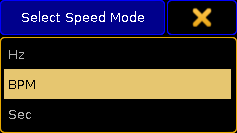
Select Speed Mode pop-up
- Trackball Function - Opens the Select Trackball Function pop-up. Here you can select the mode sequence for your trackball when you press the Mouse key. The trackball can have four different modes:
Off - no function
Mouse - normal trackball mouse function
Pan/Tilt - this will move the selected moving lights
Wheel - emulates the level wheel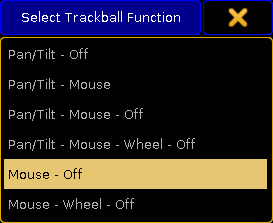
Select Trackball Function pop-up
- Trackball Resolution - Opens the Select Trackball Resolution pop-up. This is used to select the default resolution of the trackball. This can also be change on the fly by pressing the
 (encoder) key and holding it, then selecting one of the resolutions in the pop-up - more about the Encoder key following the link.There are three different resolutions:
(encoder) key and holding it, then selecting one of the resolutions in the pop-up - more about the Encoder key following the link.There are three different resolutions:
Fine (0.1% of the range)
Normal (1% of the range)
Coarse (5% of the range)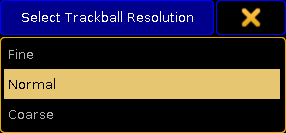
Select Trackball Resolution pop-up
- Trackball Rotation - This is used to rotate the orientation of the trackball in the pan/tilt mode. It opens a Trackball Rotation pop-up:
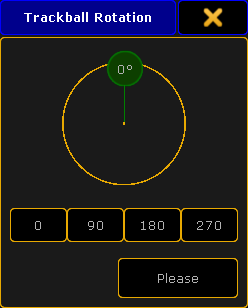
Trackball Rotation pop-up Here you can press the small green circle and rotate the orientation of the trackball. When you are happy, press the "Please" button to confirm the choice.
There are four quick options that allow for fast selection of one out of four quarters on the circle. Pressing the yellow X in the upper right corner cancels any changes.
- Dimmer Wheel Mode - Tapping this opens the Select Dimmer Wheel Mode pop-up. This is used to select the wheel mode of the level wheel. There are four options:
Additive - This will allow you to use the level wheel to set the value of dimmers. It will keep the individual levels until reaching 0% or 100%. Then it will level them out. For example: fixture 1 has a value of 50 and fixture 2 is at 60. When using the level wheel to take them both up to 100, and then back down, they both go down from 100 at the same time and at the same level.
Incremental - This will basically do the same as 'Additive', but it remembers the individual values going beyond 0% and 100%. For example: fixture 1 has a value of 50 and fixture 2 is at 60. When using the level wheel to take them both up to 100, and then back down, fixture 1 will start coming down first and then fixture 2 will follow when fixture 1 is at 90.
Prop. + (Proportional positive) - When using the level wheel to turn up the value the individual difference in value will increase. Turning down the values will make all channels reach 0% at the same time.
Prop. - (Proportional negative) - When using the level wheel to turn the values up the individual difference in value will decrease. Turning up to 100% will make all channels reach 100% at the same time.
Select Dimmer Wheel Mode pop-up
- Dimmer Wheel Resolution - This is used to select the default resolution of the Level Wheel. This can also be change on the fly by pressing the
 (Encoder) key and holding it, then selecting one of the resolutions in the pop-up - more about the Encoder key following the link.There are three different resolutions:
(Encoder) key and holding it, then selecting one of the resolutions in the pop-up - more about the Encoder key following the link.There are three different resolutions:
Fine (0.1% of the range)
Normal (1% of the range)
Coarse (5% of the range)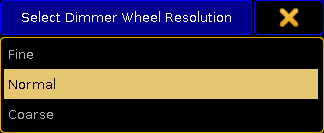
Select Dimmer Wheel Resolution - Channel Page Width - Opens the Select Channel Page Width pop-up. Here the width of the channel pages can be selected. The options are:
Default - This will add the amount of your current console.
Half Page (15 faders) - This will scale down a grandMA2 full-size or grandMA2 onPC to match a grandMA2 light or grandMA2 ultra-light.
Full Page (30 faders) - This will not add more faders to your grandMA2 light or grandMA2 ultra-light, but it will spread it out as if it was a grandMA2 full-size.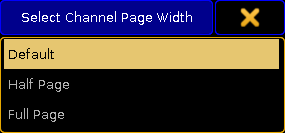
Select Channel Page Width pop-up
This cannot add more faders to your console. If there only are 15 faders then you do not get 30 - but you can scale down a grandMA2 full-size.
- Dynamic Channel Page Shows Only Selected - When this is On then the console will only display the selected fixtures in "Dynamic Channel Pages" - read more about the Dynamic Channel Pages in the Channel Pages topic.
- At Normal Percent - Here you can define what percent should be considered "At Normal". This is used when the At key is pressed twice.
- Single Digit Value - All numeric value input below 10 will be a multiplication of 10; for example: channel 1 at 5 = channel 1 gets value 50.
- Max. Program Time - This is the maximum allowed Program time for the Program Time Special Master. Follow this link Time Control to read more about the Program Time.
- Max. Exec Time - This is the maximum allowed Executor time for the Executor Time Special Master. Follow this link Time Control to read more about the Executor Time.
- Special Fader Buttons - Here you can Enable or Disable the extra buttons above the 100mm faders. Follow this link Master Section to read more about this area.
- Disable View Button and View CLI - With this option activated Views and Viewbuttons will not interact with the command line anymore. For example hitting the store button to store a group and realizing you have to change the View to get a group pool would not accidently store a view.
- Patch Column Readout is absolute DMX address - This will set the Patch columns to display the absolute DMX address instead of a universe and address split. For example with this On you will see the DMX address "2.1" (universe.address) as "513".
- XKeys always for Exec - When this is On, then the X-Keys (below screen 1) will always work as the Executor Buttons. It will not automatically follow the content on the lower part of screen 1.
- 3D Items Unit - This will change the units in the MA 3D (and Stage View). There are two options:
Scale - The visible number will be a scale of the item size.
Size(m) - The visible number will be in meters.
- CurrentChannelPage - This is this users current Channel Page.
- CurrentFaderPage - This is this users current Executor Fader Page.
- CurrentButtonPage - This is this users current Executor Button Page.
- EncoderLink - The encoder link is used when working in the Fade, Delay and Effect layers. It has several options:
Single - Only sets the value for the attribute you change.
Single Active - Same as above, but limited to parameters that are already active in programmer.
Feature - Sets the value for all attributes in the selected feature. For example if you set a delay time for 'Pan' it will also set the time for 'Tilt'.
Feature Active - Same as above, but limited to parameters that are already active in programmer.
All - This sets the value for all attributes.
All Active - Same as above, but limited to parameters that are already active in programmer.
Filter - Sets the value for the attributes selected in the current filter from the filter pool or at filter.
Filter Active - Same as above, but limited to parameters that are already active in programmer.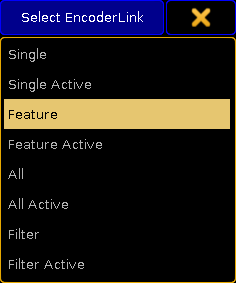
Select Encoder Link pop-up - Programmer Colors - This setting allows to change between two different set of visual color feedback regarding the programmer. The two options are Standard and High Contrast. Read about the in the System Colors topic.


